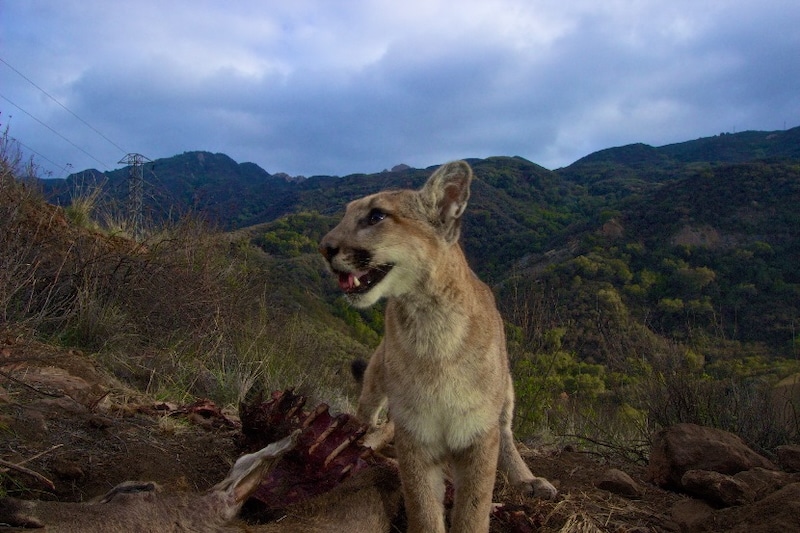This post was originally published on Eco Watch
In a symptom of human development pushing native wildlife further outside their natural habitats, mountain lions living in the greater Los Angeles area have been changing the timing of their activities to avoid interactions with hikers, joggers, cyclists and other recreationists, according to a new study led by researchers at University of California, Davis (UC Davis).
The researchers found that mountain lions who lived in areas with more human recreation had shifted to become increasingly nocturnal compared with more remote-dwelling lions, who were primarily active around dawn and dusk, a press release from UC Davis said.
“People are increasingly enjoying recreating in nature, which is fantastic,” said lead author of the study Ellie Bolas, a UC Davis Ph.D. candidate in the Department of Wildlife, Fish and Conservation Biology, in the press release. “This flexibility we see in mountain lion activity is what allows us to share these natural areas together. Mountain lions are doing the work so that coexistence can happen.”
The authors said the findings offered a hopeful example of the coexistence of wildlife and humans in a large, densely populated area.
“Mountain lions prefer to avoid people, but in a metro area of more than 18 million people, natural areas inhabited by mountain lions and other wildlife are also heavily used by recreationists,” the press release said.
To find out if and in what ways mountain lions were shifting their activities in response to the recreationists, the research team monitored 22 lions’ movements in and around the Santa Monica Mountains from 2011 to 2018.
Biologists captured lions living inside the Santa Monica Mountains National Recreation Area and fitted them with GPS and accelerometer collars. They then analyzed the data, quantifying the area’s human recreational activity using a global database of activities tracked by GPS.
“These results are really important in that they show how humans may be affecting wildlife in less obvious ways than killing them with vehicles,” said Seth Riley, the park’s head of wildlife, in the press release. “The study also continues to drive home the amazing fact that a population of a large felid predator persists in one of the largest urban areas in the world. That would not be possible if mountain lions weren’t able to adjust to human activity in ways like this.”
The findings demonstrated that the highest recreational activity levels were in Griffith Park, while Los Padres National Forest and the Santa Susana Mountains had the least amount of activity.
“The least nocturnal mountain lion was female P13 in the central and western Santa Monica Mountains. Females, in general, were found to be more active closer to sunrise and during daylight hours as compared to males,” the press release said.
Female P13 was the least nocturnal mountain lion studied. National Park Service
The authors said the reason for that could be so female cats can avoid running into males, who pose a danger to them and their kittens.
Two male mountain lions occupying isolated natural areas with an abundance of trails, high recreation levels, surrounding freeways and intense development were the most nocturnal. Both lived in two of the most limited home ranges for adult males ever recorded. The most nocturnal lion in the study — P41 — lived in the small Verdugo Mountain Range, which spans several cities.

Male P41, the most nocturnal mountain lion in the study, who lived in the Verdugo Mountains near Los Angeles, an area with high levels of human recreation. National Park Service
The second most nocturnal of the lions was P22, who lived in Griffith Park and became famous for crossing two busy freeways when he was young. He continued to occupy the area until he was killed in 2022 at 12 years old — one of the most senior cats in the study.

P-22 was among the mountain lions of Los Angeles who shifted his activities to be more nocturnal. National Park Service
The study’s authors said the lions in the study show how mountain lions actively avoid humans when faced with increased activity, rather than habituating themselves to them.
The authors said that doesn’t mean mountain lions should have to do all the work. Humans can help protect them, as well as themselves, by remembering that they are likely to be active at dawn or dusk in populated areas, and be on the lookout for them when driving at night.
In the Los Angeles area, mountain lions face many challenges and dangers, including busy roads where they are often killed, fragmented habitat, exposure to rodenticide and low genetic diversity.
“Even something as innocuous as recreation can add to these other stressors we’re bringing into their lives, potentially by altering the amount of energy they have to expend for hunting and other needs,” Bolas said in the press release. “But we can feel a sense of optimism that they are flexible in the timing of their activity. Coexistence is happening, and it’s in large part because of what mountain lions are doing.”
The study, “Human recreation influences activity of a large carnivore in an urban landscape,” was published in the journal Biological Conservation.
The post ‘Coexistence Is Happening’: LA Mountain Lions Change Their Hours to Avoid Recreationists appeared first on EcoWatch.





0 Comments